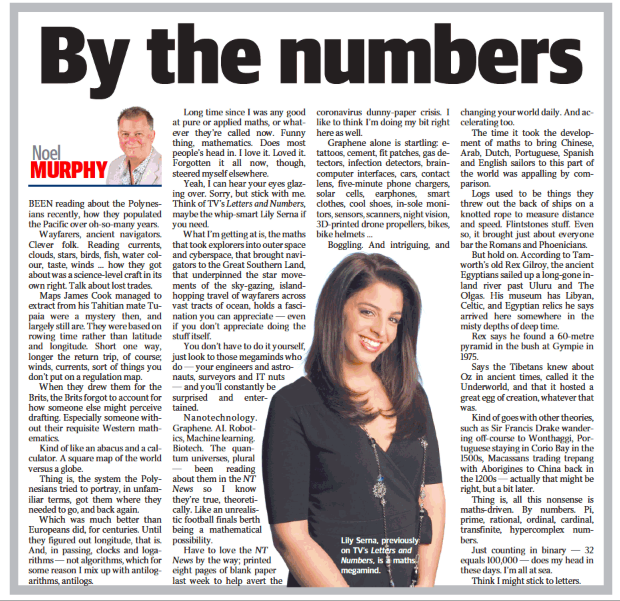
BEEN reading about the Polynesians recently, how they populated the Pacific over oh-so-many years.
Wayfarers, ancient navigators. Clever folk. Reading currents, clouds, stars, birds, fish, water colour, taste, winds … how they got about was a science-level craft in its own right. Talk about lost trades.
Maps James Cook managed to extract from his Tahitian mate Tupaia were a mystery then, and largely still are. They were based on rowing time rather than latitude and longitude. Short one way, longer the return trip, of course; winds, currents, sort of things you don’t put on a regulation map.
When they drew them for the Brits, the Brits forgot to account for how someone else might perceive drafting. Especially someone without their requisite Western mathematics.
Kind of like an abacus and a calculator. A square map of the world versus a globe.
Thing is, the system the Polynesians tried to portray, in unfamiliar terms, got them where they needed to go, and back again.
Which was much better than Europeans did, for centuries. Until they figured out longitude, that is. And, in passing, clocks and logarithms — not algorithms, which for some reason I mix up with antilogarithms, antilogs.
Long time since I was any good at pure or applied maths, or whatever they’re called now. Funny thing, mathematics. Does most people’s head in. I love it. Loved it. Forgotten it all now, though, steered myself elsewhere.
Yeah, I can hear your eyes glazing over. Sorry, but stick with me. Think of TV’s Letters and Numbers, maybe the whip-smart Lily Serna if you need.
What I’m getting at is, the maths that took explorers into outer space and cyberspace, that brought navigators to the Great Southern Land, that underpinned the star movements of the sky-gazing, islandhopping travel of wayfarers across vast tracts of ocean, holds a fascination you can appreciate — even if you don’t appreciate doing the stuff itself.
You don’t have to do it yourself, just look to those megaminds who do — your engineers and astronauts, surveyors and IT nuts
— and you’ll constantly be surprised and entertained.
Nanotechnology. Graphene. AI. Robotics, Machine learning. Biotech. The quantum universes, plural
— been reading about them in the NT News so I know they’re true, theoretically. Like an unrealistic football finals berth being a mathematical possibility.
Have to love the NT News by the way; printed eight pages of blank paper last week to help avert the coronavirus dunny-paper crisis. I like to think I’m doing my bit right here as well.
Graphene alone is startling: etattoos, cement, fit patches, gas detectors, infection detectors, braincomputer interfaces, cars, contact lens, five-minute phone chargers, solar cells, earphones, smart clothes, cool shoes, in-sole monitors, sensors, scanners, night vision, 3D-printed drone propellers, bikes, bike helmets …
Boggling. And intriguing, and changing your world daily. And accelerating too.
The time it took the development of maths to bring Chinese, Arab, Dutch, Portuguese, Spanish and English sailors to this part of the world was appalling by comparison.
Logs used to be things they threw out the back of ships on a knotted rope to measure distance and speed. Flintstones stuff. Even so, it brought just about everyone bar the Romans and Phoenicians.
But hold on. According to Tamworth’s old Rex Gilroy, the ancient Egyptians sailed up a long-gone inland river past Uluru and The Olgas. His museum has Libyan, Celtic, and Egyptian relics he says arrived here somewhere in the misty depths of deep time.
Rex says he found a 60-metre pyramid in the bush at Gympie in 1975.
Says the Tibetans knew about Oz in ancient times, called it the Underworld, and that it hosted a great egg of creation, whatever that was.
Kind of goes with other theories, such as Sir Francis Drake wandering off-course to Wonthaggi, Portuguese staying in Corio Bay in the 1500s, Macassans trading trepang with Aborigines to China back in the 1200s — actually that might be right, but a bit later.
Thing is, all this nonsense is maths-driven. By numbers. Pi, prime, rational, ordinal, cardinal, transfinite, hypercomplex numbers.
Just counting in binary — 32 equals 100,000 — does my head in these days. I’m all at sea.
Think I might stick to letters.
This article appeared in the Geelong Advertiser 10 March 2020.
https://regionalnews.smedia.com.au/geelongadvertiser/TranslateArticle.aspx?doc=NCGA%2F2020%2F03%2F10&entity=ar01703


